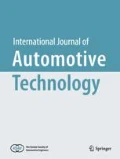Abstract
This study investigates the compressible-brake-fluid flow characteristics within an electric parking brake (EPB) caliper during the bleeding cycles, subsequently determines the fundamental cause for reduction in brake-bleeding performance, and suggests a new design for its improvements. Three-dimensional simulation validation of the brake-fluid consumption curve is conducted through the parameter study of the air mass flow and bulk modulus. A numerical approach utilizing a three-phase (air, brake-fluid, and brake-fluid vapor) mixture model and a standard k-ω turbulence model is adopted to investigate the flow field details. Based on the unsteady simulation results and experimental verifications for the current and new models of the nut-spindle of a driving part in the EPB caliper, the primary cause for the reduction in the bleeding performance in the EPB caliper is determined to be the trapped air in the thread gap and in the space between the spindle and nut-spindle. Consequently, the head chamfer effect for the nut spindle is beneficial for removing trapped air and leads to performance improvement of 30.3 %.
Similar content being viewed by others
Abbreviations
- k:
-
bulk modulus at pressure
- K0 :
-
reference bulk modulus
- N:
-
density exponent
- p:
-
liquid pressure (absolute)
- p0 :
-
reference liquid pressure (absolute)
- \({\vec v_m}\) :
-
mass-averaged velocity
- ρ:
-
liquid density at pressure
- ρ0 :
-
reference liquid density
- ρk :
-
density of phase k
- ρm :
-
mixture density
- αk :
-
volume fraction of phase k
- \(\vec g\) :
-
gravity, 9.81 m/s2
References
Abbas, S. A., Cubitt, N. J. and Hooke, C. J. (1969). Temperature distributions in disc brakes. Proc. Institution of Mechanical Engineers: Automobile Division 184, 1, 185–194.
Anton, I. (1993). The effects of turbulence on cavitation inception. La Houille Blanche, 5, 315–322.
Brake bleeding (2019). https://en.wikipedia.org/wiki/Brake_bleeding
Braking system (2019). https://en.wikibooks.org/wiki/Automotive_Systems/Braking_System/
Day, A. J. and Newcomb, T. P. (1984). The dissipation of frictional energy from the interface of an annular disc brake. Proc. Institution of Mechanical Engineers, Part D: Transport Engineering 198, 3, 201–209.
Gholizadeh, H. (2013). Modeling and experimental evaluation of the effective bulk modulus for a mixture of hydraulic oil and air. Ph.D. thesis, University of Saskatchewan Saskatoon.
Hunter, J. E., Cartier, S. S., Temple, D. J., and Mason, R. C. (1998) Brake fluid vaporization as a contributing factor in motor vehicle collisions. SAE Trans., 867–885.
Limpert, R. (1975). The thermal performance of automotive disc brakes. SAE Trans., 2355–2368.
Mo, J. O. (2018). Compressible brake fluid turbulent flow simulation and experimental verification on brake bleeding performance improvements of an EPB caliper. SAE Technical Paper No. 2018-01-1876.
Mo, J. O. (2020). Effect of holes brake-bleeding performance improvement in the EPB caliper. Int. J. Automotive Technology 21, 2, 319–328.
Newcomb, T. P. (1960). Temperatures reached in disc brakes. J. Mechanical Engineering Science 2, 3, 167–177.
Noyes, R. N. and Vickers, P. T. (1969) Prediction of surface temperatures in passenger car disc brakes. SAE Trans., 1653–1658.
Sheridan, D. C., Kutchey, J. A., and Samie, F. (1988) Approaches to the thermal modeling of disc brakes. SAE Trans., 268–283.
Tait equation (2019). https://en.wikipedia.org/wiki/Tait_equation
Zwart, P. J., Gerber, A. G., and Belamri, T. (2004). A two-phase flow model for predicting cavitation dynamics. In 5th Int. Conf. Multiphase Flow. Yokohama, Japan.
Acknowledgement
This work was supported by Mun-Seong Kim and Seung-Woo Han at the MBS R&D Center in the Mando Corporation.
Author information
Authors and Affiliations
Corresponding author
Additional information
Publisher’s Note Springer Nature remains neutral with regard to jurisdictional claims In published maps and Institutional affiliations.
Rights and permissions
About this article
Cite this article
Mo, Jo. Numerical and Experimental Investigation of Compressible-Brake-Fluid Flow Characteristics and Brake-Bleeding Performance in EPB Caliper. Int.J Automot. Technol. 22, 315–325 (2021). https://doi.org/10.1007/s12239-021-0030-6
Received:
Revised:
Accepted:
Published:
Issue Date:
DOI: https://doi.org/10.1007/s12239-021-0030-6



